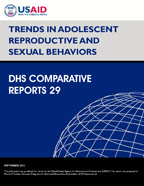- PUBLICATIONS
- JOURNAL ARTICLES
- ACCESS PUBLICATIONS
Publications Summary
- Document Type
- Comparative Reports
- Publication Topic(s)
- Youth
- Language
- English
- Recommended Citation
- Kothari, Monica T., Shanxiao Wang, Sara K. Head, and Noureddine Abderrahim. 2012. Trends in Adolescent Reproductive and Sexual Behaviors. DHS Comparative Reports No. 29. Calverton, Maryland, USA: ICF International.
- Download Citation
- RIS format / Text format / Endnote format
- Publication Date
- September 2012
- Publication ID
- CR29
Download
 Trends in Adolescent Reproductive and Sexual Behaviors (PDF, 2534K)
Trends in Adolescent Reproductive and Sexual Behaviors (PDF, 2534K)
